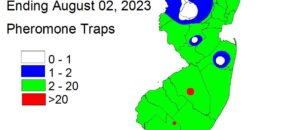EPA Seeks Public Comments to Ensure Information on Bilingual (Spanish) Pesticide Labels Reaches the Hands of America’s Farmworkers [Posted to EPA OPP Update August 3, 2023]. The U.S. Environmental Protection Agency (EPA) is seeking public comments on h… Read More »
Continue reading...Bilingual Labeling: Parts of Pesticide Labels Will be Required to Also Be In Spanish
Vegetable IPM Update 8/02/23

Sweet Corn Occurrences of Fall armyworm (FAW) injury are becoming more common, with infestations discovered as far north as Warren County this week. Some infestations in whorl corn are in excess of 20%. It is likely that economic infestations are present in much of southern New Jersey now, and could occur anywhere. Growers are advised […]
Continue reading...Rutgers Tree Fruit IPM Report for August 02, 2023
Peach: Oriental Fruit Moth: A biofix point for OFM was set on 4/10 in both northern and southern counties. All timings for first generation OFM have past. Third generation timings are updated below: OFM 2nd Generation Timing Insecticide Type County/Region Degree Days by 7/25 base 45 Conventional 2100-2200 2350-2450 Diamide 2025-2150 2375-2450 Gloucester – Southern […]
Continue reading...Diazinon Shortage and Future Production
This article has been adapted from an article written by Dr. Christelle Guédot, University of Wisconsin-Madison, and published in the Cranberry Crop Management Journal – Volume 36 (August 02). Every 15 years, the Environmental Protection Agency (EPA) performs registration reviews to reevaluate pesticides to assess environmental and occupational risk. In March 2023, the EPA announced […]
Continue reading...Vegetable Disease Update: 07-29-23
Basil downy mildew has been reported in New Jersey. Rhizoctonia root rot has been reported in tomato and other vegetable crops. Phomopsis and Phytophthora fruit rot has been reported in eggplant. Collar rot has been reported on tomato. For more information please click here. Pythium cottony leak has been reported on pepper. For more information […]
Continue reading...What do the terms in a feed analysis mean?
We have had a requests for information about heat damaged hay and forage. Forage put up too wet will overheat and may result in unavailable protein and hay unsuitable for ruminant digestion. A definition of the terms in a feed analysis may be useful. Some of these terms are useful for ruminant animals (cattle, sheep, […]
Continue reading...